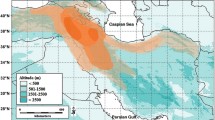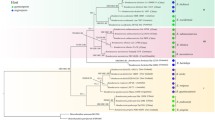Abstract
This molecular phylogenetic analysis of 18S ribosomal RNA (18SrDNA) gene sequences from 16 species of holothuroid, suggests strong support for an alternative taxonomic scheme to replace the existing classification. When trees drawn from the 18S rDNA data were constrained to show expected relationships between the holothourid orders, they were significantly worse than the best tree under SH tests. These analyses indicated strongly that the subclass Aspidochirotacea is paraphyletic. Sequences from the order Dendrochirotida grouped with aspidochiroitid sequences, with high bootstrap support, to the exclusion of the elasipod sequence. In line with recent morphological studies the order Apodida were a basal sister group to the other three holothuroid orders examined and the Dendrochirotida was a derived holothuroid order.

Similar content being viewed by others
References
Arndt A, Marquez C, Lambert P, Smith MJ (1996) Molecular phylogeny of eastern pacific sea cucumbers (Echinodermata: Holothuroidea) based on mitochondrial DNA sequence. Mol Phy Evol 6(3):425–437
Cuénot L (1891) Études morphologiques sur les échinoderms. Arch de Biologie 11: 313–680, pls 24–31
Hansen B (1975) Systematics and biology of the deep-sea holothurians. Part 1. Elasipoda, vol 13. In: Wolff T (ed) Galathea Reports. Scientific results of the danish deep-sea expedition round the world 1950–52. Scandinavian Science Press, Copenhagen, pp 1–262
Haude R (1992) Fossil holothurians: sclerite aggreates as “good” species. In: Scalera- Liaci L, Canicatti C (eds) Echinoderm research 1991. AA Balkema, Rotterdam, pp 29–33
Hillis DM, Bull JJ (1993) An empirical test of bootstrapping as a method for assessing confidence in phylogenetic analysis. Syst Biol 42:182–192
Hillis DM, Huelsenbeck JP (1992) Signal, noise, and reliability in molecular phylogenetic analyses. Heredity 83:189–195
Huelsenbeck JP, Crandall KA (1997) Phylogeny estimation and hypothesis testing using maximum likelihood. Ann Rev Ecol Syst 28:437–466
Huxley TH (1878) Anatomy of invertebrate animals. Murray, London
Kerr A (2000) Evolution and systematics of Holothuroidea (Echinodermata). Thesis, Yale University
Kerr A, Kim J (1999) Bi-penta-bi-decaradial symmetry: a review of evolutionary and developmental trends in Holothuroidea (Echinodermata). J Exp Zool (Molecular and Developmental Evolution) 285:93–103
Kerr AM, Kim J (2001) Phylogeny of Holothuroidea (Echinodermata) inferred from morphology. Zool J Linn Soc 133:63–81
Kerr AM, Stoffell EL, Yoon RL (1993) Abundance distribution of holothuroids (Echinodermata: Holothuroidea) on a windward and leeward fringing coral reef, Guam, Mariana Islands. Bull Mar Sci 52:780–791
Littlewood DTJ, Smith ABS (1995) A combined morphological and molecular phylogeny for sea urchins (Echinoidea: Echinodermata). Philos Trans R Soc Lond B 347:213–234
Littlewood DTJ, Smith ABS, Clough KA, Emson RH (1997) The interrelationships of the echinoderm classes: morphological and molecular evidence. Biol J Linn Soc 61:409–438
Maddison DR, Maddison WP (2001) MacClade 4.0. Sinauer Associates Inc. Sunderland
Massin C (1999) Reef-dwelling Holothuroidea (Echinodermata) of the Spermonde Archipelago (South-West Sulawesi, Indonesia). Zoologische Verhandelingen 329:144
Mortensen T (1927) Handbook of the Echinoderms of the British Isles. Oxford University Press, p 471
Östergren H (1907) Zur phylogenie und systematik der seewalzen. Sartryck ur zoologiska Studier 1:191–215
Panning A (1944) Die Trepangfischerei. Mitt hamb Zool Mus Inst 49:2–76
Pawson DL, Fell HB (1965) A revised classification of the dendrochirote holothurians. Breviora 214:1–7
Posada D, Crandall KA (1998) Modeltest: testing the model of DNA substitutions. Bioinformatics 14(9):817–818
Reich M (1999) Über Achistrum huckei (Frizzell& Exline, 1956) [Holothuroidea, Echinodermata] aus der Unterkreide von Bartin (Hinterpommern). Griefswalder Geowissenschaftliche Beiträge 6:383–391
Reyes-Leonardo LD (1984a) A taxonomic report of shallow water Holothurians of Calatagan, Batangas. Philipp J Sci 113(3–4):137–172
Rowe FWE, Doty JE (1977) The shallow-water holothurians of Guam. Micronesica 13(2):217–250
Rowe FWE, Gates J (1995) Echinodermata. In: Wells (ed) Zoological Catalogue of Australia, vol 33: I-xiii. CSIRO Australia, pp 1–510
Seilacher A (1961) Holothurien im Hunsrückschiefer (Unter Devon). Notizblatt des hessischen Landesamtes für Bodenforschung zu Wiesbaden 89:66–72
Semper C (1868) Reisen im Archipel der Philippinen. 2. Wissenschaftliche Resultate 1, Holothurien. Leipzig, Wilhelm Engelmann
Semón R (1888) Die Entwicklung der Synapta digitata und die Stammesgeschichte der Echinodermen. Jenaische Zeitschrift für wissenschaft Naturw 22:1–135, pl VI–XII
Shimodaira H, Hasegawa M (1999) Multiple comparisons of log-likelihoods with applications to phylogenetic inference. Mol Biol Evol 16:1114–1116
Smiley S (1994) Holothuroidea. In: Harrison FW, Chia FS (eds) Microscopic anatomy of invertebrates, vol 14. Echinodermata. Wiley-Liss, New York, pp 401–471
Smiley S, Pawson DL (1991) An annotated catalogue of the holothurians. Unpublished manuscript, p 184
Smith AB (1997) Echinoderm larvae and phylogeny. Ann Rev Ecol Syst 28:219–241
Strimmer K, von Haeseler A (1996) Quartet puzzling: a quartet maximum- likelihood method for reconstructing tree topologies. Mol Biol Evol 13(7):964–969
Swofford DL (1998) Paup*. Phylogenetic Analysis Using Parsimony (and Other Methods). Version 4. Sinauer Associates, Sunderland
Tamura K, Nei M (1993) Estimation of the number of nucleotide substitutions in the control region of mitochondrial DNA in humans and chimpanzees. Mol Biol Evol 10(3):512–526
Tan Tiu AS (1981) The intertidal Holothurian fauna (Echinodermata: Holothuroidea) of Mactan and the neighbouring Islands, Central Philippines. Philipp J Sci 18:45–119
Thompson JD, Gibson TJ, Plewniak F, Jeanmougin F, Higgins DG (1997) The CLUSTAL-X windows interface: flexible strategies for multiple sequence alignment aided by quality analysis tools. Nucl Acids Res 25:4876–4882
Wada H, Satoh N (1994) Phylogenetic relationships among extant classes of echinoderms, as inferred from sequences of 18S rDNA, coincide with relationships deduced from the fossil record. J Mol Evol 38:41–49
Winnepenninckx B, De Baere R, Backeljau T, De Wachter R (1995) The phylogenetic relationships of the Holothuroidea (Echinodermata). Evidence from 18S rRNA data. (Unpublished)
Acknowledgements
The authors wish to dedicate this manuscript to the memory of Prof. Brendan Keegan and Dr. Richard Powell who have passed away. K.M.J. Lacey gratefully acknowledges the support and assistance provided throughout this research by Alexander Kerr, Dave Pawson and Dai Roberts. Thanks are also extended to Andrew Smith. This research was funded by Enterprise Ireland, National University of Ireland, Galway, and Wexford County Council. All experiments were carried out in Ireland and complied with current Irish laws.
Author information
Authors and Affiliations
Corresponding author
Additional information
Communicated by O. Kinne, Oldendorf/Luhe
Brendan F. Keegan, Richard Powell: R.I.P
Rights and permissions
About this article
Cite this article
Lacey, K.M.J., McCormack, G.P., Keegan, B.F. et al. Phylogenetic relationships within the class holothuroidea, inferred from 18S rRNA gene data. Marine Biology 147, 1149–1154 (2005). https://doi.org/10.1007/s00227-005-0009-2
Received:
Accepted:
Published:
Issue Date:
DOI: https://doi.org/10.1007/s00227-005-0009-2




